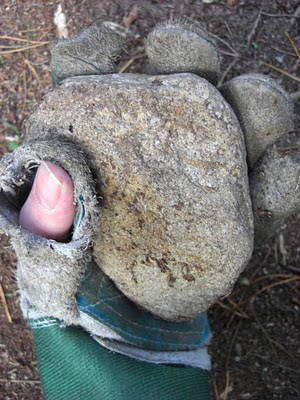Toilet training should only take about a week and the pup needs to be praised for doing their business outside, not reprimanded for doing it on the front room carpet. It is yet again a case of me being trained as well as Kenny (or Kenneth as I like to call him much to the annoyance of the rest of the family). His mother, Chips, has taken to running out of the house in the morning and hiding in the woods, coming back covered in bramble thorns and gorse, only to eat and sleep. She keeps a distance from her offspring now as he has a fine set of sharp teeth which must make feeding a bit of a painful procedure. Her chair is still too high for Kenneth to jump onto so Chips just stares at him dismissingly as he tries to get to her. Parenthood, isn’t it wonderful?
I read that a puppy needs to be taken out every hour and told to do its business. I might as well use this time productively so instead of standing there saying “do a wee wee” (the websites suggestion, not mine,) I am finding outdoor jobs to do. This should keep all three of us happy. I can release my frustrations by doing a bit of manual work, Chips can hide in the gorse and Kenneth can frolic around and eat fallen leaves.
Clearing Pathways
The autumn leaves are looking particularly beautiful at the moment, we have a few really bright varieties of acers that go scarlet in colour before falling, and we have a sorbus and a birch tree to add to the rainbow of colours. I’m outside to clear the path of leaves in the front garden today and notice that the path needs other work to make it safe for the winter. I have three jobs to do (four if you count keeping an eye on the puppy)1. Clear the path of weeds
2. Clear the steps leading up to the path
3. Wash the path down to stop it from becoming slippery when wet.
Clear the path of weeds
The path is crazy paving and over the year annual and perennial weeds have grown in the cracks. I’m not as organised as the bloke working on the Credit Union grounds in Buncrana. He has a stick with a nail on the end and he scrapes out all of the dirt and weeds from the path cracks. I’m not so exacting with the weeds on my path and jut hack the tops off with a spade. I’m careful to make sure that Kenneth is preoccupied chewing on a cotoneaster stump before commencing. I also clear the edges of the path where the grass is beginning to encroach into the crazy paving.
Clear the steps leading up to the path
Whoever washes the dishes at the kitchen sink looks up the path through the window and I couldn’t help but notice that groundcover plants are covering most of the four steps leading to the path. I used the excuse that I liked the plants cascading over the rockery stones for a year or two now, but they are full of creeping buttercup, clover, couch grass, London pride and ivy. Chances are that it was just supposed to be London pride growing over onto the path but everything else has been mixed up in it over the years. I wouldn’t be bothered to pick the weeds from the mess so I pull everything back off of the steps back to the rockery stones, the clumps came up easily, even with a young puppy behind me hanging from my jumper. It’s amazing how wide the path is now that the clumps have gone. I am now in a position to allow only the plants that I want to grow onto the steps without having to do any weeding.
Wash the path down
I’m just using soapy water and a stiff brush with a dog on the end for this. I don’t want, or need to use any harsh chemicals for this, especially with soft paws running about. The stones can get really slippery when algae grows on it so it really needs doing once or twice a year, -even more if the pathways are in a lot of shade. It only takes a few weeks for the paths to be dangerous.
I have a couple of wheelbarrow loads of weeds from the path and as I empty the contents onto the compost heap I look at Kenneth and find myself saying. “Time to go back inside. Do a wee wee”.
Did I really just say that?






